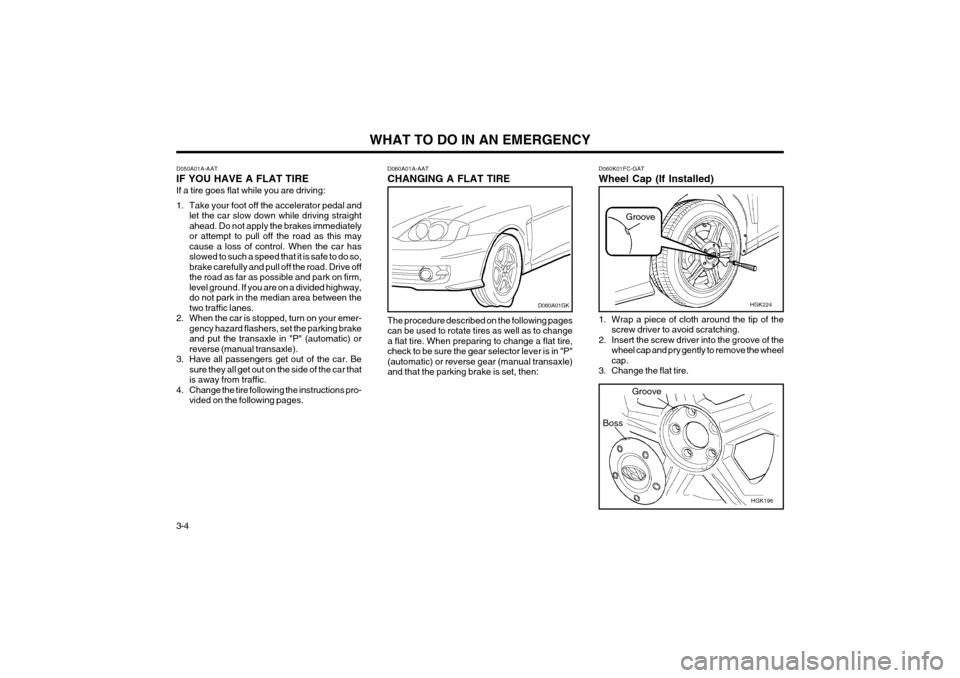2004 Hyundai Coupe change wheel
[x] Cancel search: change wheelPage 36 of 389

FEATURES OF YOUR HYUNDAI
1- 28
B260J01S-GAT Charging System Warning Light
The charging system warning light should come on when the ignition is turned on, then go outwhen the engine is running. If the light stays onwhile the engine is running, there is a malfunctionin the electrical charging system. If the lightcomes on while you are driving, stop, turn off theengine and check under the hood. First, makecertain the generator drive belt is in place. If it is,check the tension of the belt.And then, have the system checked by yourHyundai dealer. CAUTION: If the drive belt (generator belt) is loose,broken, or mission while the vehicle is driv-ing, there may be a serious malfunction, en-gine could overheat because this belt alsodrives the water pump. B260L01A-GAT
Door Ajar Warning Light
The door ajar warning light warns you that a dooris not completely closed.
B260H01GK-AAT Parking Brake/Low Brake Fluid Level Warning Light
CAUTION: If you suspect brake trouble, have your brakeschecked by a Hyundai dealer as soon aspossible. Driving your car with a problem ineither the brake electrical system or brakehydraulic system is dangerous, and couldresult in a serious injury or death. Warning Light Operation The parking brake/brake fluid level warning light should come on when the parking brake is ap-plied and the ignition switch is turned to "ON" or"START". After the engine is started, the lightshould go out in three seconds.If the parking brake is not applied, the warninglight should come on when the ignition switch isturned to "ON" or "START", then go out in threeseconds. If the light comes on at any other time,you should slow the vehicle and bring it to acomplete stop in a safe location off the roadway.The brake fluid level warning light indicates thatthe brake fluid level in the brake master cylinderis low and hydraulic brake fluid conforming toDOT 3 or DOT 4 specifications should be added.After adding fluid, if no other trouble is found, thecar should be immediately and carefully driven toa Hyundai dealer for inspection. If further troubleis experienced, the vehicle should not be drivenat all but taken to a dealer by a professionaltowing service or some other safe method. Your Hyundai is equipped with dual-diagonalbraking systems. This means you still have brak-ing on two wheels even if one of the dual systemsshould fail. With only one of the dual systemsworking, more than normal pedal travel andgreater pedal pressure are required to stop thecar. Also, the car will not stop in as short adistance with only half of the brake system work-ing. If the brakes fail while you are driving, shift toa lower gear for additional engine braking andstop the car as soon as it is safe to do so.
B260M01A-AAT
Low Fuel Level Warning Light
The low fuel level warning light comes on when the fuel tank is approaching empty. When itcomes on, you should add fuel as soon aspossible. Driving with the fuel level warning lighton or with the fuel level below "E" can cause theengine to misfire and damage the catalytic con-verter.
B260K01F-AAT Tail Gate Open Warning Light
This light remains on unless the tail gate is completely closed and latched.
B265C01O-AAT Traction Control Indicator Lights (If installed)
The traction control indicators change operation according to the ignition switch position andwhether the system is in operation or not.They will illuminate when the ignition key isturned to the "ON" position, but should go outafter three seconds. If the TCS or TCS-OFF
Page 100 of 389

DRIVING YOUR HYUNDAI 2- 5
C070D03A-AAT Good Driving Practices
o Never take the car out of gear and coast down
a hill. This is extremely hazardous. Always leave the car in gear.
o Don't "ride" the brakes. This can cause them to overheat and malfunction. Instead, whenyou are driving down a long hill, slow downand shift to a lower gear. When you do this,engine braking will help slow the car.
o Slow down before shifting to a lower gear. This will help avoid over-revving the engine,which can cause damage.
o Slow down when you encounter cross winds. This gives you much better control of yourcar.
o Be sure the car is completely stopped before you attempt to shift into reverse. The transaxlecan be damaged if you do not. To shift intoreverse, depress the clutch, move the shiftlever to neutral, wait three seconds, then shiftto the reverse position.
o Exercise extreme caution when driving on a slippery surface. Be especially careful whenbraking, accelerating or shifting gears. On aslippery surface, an abrupt change in vehiclespeed can cause the drive wheels to losetraction and the vehicle to go out of control. WARNING:
o Avoid high cornering speeds.
o Do not make quick steering wheel move-
ments, such as sharp lane changes orfast, sharp turns.
o Always wear your seat belts. In a collision crash, un unbelted person issignificantly more likely to die than a per-son wearing a seatbelt.
o The risk of rollover is greatly increased if you lose control of your vehicle at high-way speeds.
o Loss of control often occurs if two or more wheels drop off the roadway and the driveroversteers to reenter the roadway.
o In the event your vehicle leaves the road- way, do not steer sharply. Instead, slowdown before pulling back into the travellanes.
o Never exceed posted speed limits.
1-2 2-33-4 4-5 5-6
C070E01GK-GAT RECOMMENDED SHIFT POINTSThe shift points as shown below are recom- mended for optimum fuel economy and perfor-mance. A Type (5 speed)
1-2 2-33-4 4-5
Shift
from-to Recommended
20 km/h (15 mph) 40 km/h (25 mph) 55 km/h (35 mph) 75 km/h (45 mph)
Shift
from-to Recommended
15 km/h (10 mph) 35 km/h (20 mph) 50 km/h (30 mph) 70 km/h (45 mph)95 km/h (60 mph)
B Type (6 speed)
Page 103 of 389

DRIVING YOUR HYUNDAI
2- 8 C130A01A-AAT GOOD BRAKING PRACTICES WARNING: Nothing should be carried on top of the shelfpanel behind the rear seat. If there were anaccident or a sudden stop, such objects couldmove forward and cause damage to the ve-hicle or injure the occupants.
o After being parked, check to be sure the
parking brake is not engaged and that the parking brake indicator light is out beforedriving away.
o Driving through water may get the brakes wet. They can also get wet when the car iswashed. Wet brakes can be dangerous! Yourcar will not stop as quickly if the brakes arewet. Wet brakes cause the car to pull to one
side. To dry the brakes, apply the brakeslightly until the braking action returns to nor-mal, taking care to keep the car under controlat all times. If the braking action does notreturn to normal, stop as soon as it is safe todo so and call your Hyundai dealer for assis-tance.
o Don't coast down hills with the car out of gear. This is extremely hazardous. Keep the car ingear at all times, use the brakes to slow down,then shift to a lower gear so that enginebraking will help you maintain a safe speed.
o Don't "ride" the brake pedal. Resting your foot on the brake pedal while driving can be dan-gerous because it can result in the brakes
overheating and losing their effectiveness. It
C090I01L-GAT CAUTION:
o Shift into "R" and "P" position only when
the vehicle has completely stopped.
o Do not accelerate the engine in reverse or any of the forward positions with the brakes applied.
o Always apply the footbrake when shifting from "P" or "N", to "R", "D"position.
o Do not use the "P" (Park) position in place of the parking brake. Always set the park-ing brake, shift the transaxle into "P" (Park)position and turn off the ignition whenyou leave the vehicle, even momentarily.Never leave the vehicle unattended whilethe engine is running.
o Check the automatic transaxle fluid level regularly, and add fluid as necessary.
C090N02O-AAT Good Driving Practices
o Never move the gear selector lever from "P" or "N" to any other position with the acceler- ator pedal depressed.
o Never move the gear selector lever into "P" when the vehicle is in motion.
o Be sure the car is completely stopped before you attempt to shift into "R".
o Never take the car out of gear and coast down a hill. This may be extremely hazardous.Always leave the car in gear when moving.
o Do not "ride" the brakes. This can cause them to overheat and malfunction. Instead, whenyou are driving down a long hill, slow down and shift to a lower gear. When you do this,engine braking will help slow the car.
o Slow down before shifting to a lower gear. Otherwise, the lower gear may not be en-gaged.
o Always use the parking brake. Do not depend on placing the transaxle in "P" to keep the carfrom moving.
o Exercise extreme caution when driving on a slippery surface. Be especially careful whenbraking, accelerating or shifting gears. On aslippery surface, an abrupt change in vehiclespeed can cause the drive wheels to losetraction and the vehicle to go out of control.
WARNING:
o Avoid high cornering speeds.
o Do not make quick steering wheel move- ments, such as sharp lane changes orfast, sharp turns.
o Always wear your seat belts. In a collision crash, un unbelted person issignificantly more likely to die than a per-son wearing a seatbelt.
o The risk of rollover is greatly increased if you lose control of your vehicle at high-way speeds.
o Loss of control often occurs if two or more wheels drop off the roadway and the driveroversteers to reenter the roadway.
o In the event your vehicle leaves the road- way, do not steer sharply. Instead, slowdown before pulling back into the travellanes.
o Never exceed posted speed limits.
Page 106 of 389

DRIVING YOUR HYUNDAI 2- 11
off your engine and restart only when you're ready to go.
o Remember, your Hyundai does not require extended warm-up. As soon as the engine isrunning smoothly, you can drive away. Invery cold weather, however, give your enginea slightly longer warm-up period.
o Don't "lug" or "over-rev" the engine. Lugging is driving too slowly in too high a gear result-ing in the engine bucking. If this happens, shiftto a lower gear. Over-revving is racing theengine beyond its safe limit. This can beavoided by shifting at the recommendedspeeds.
o Use your air conditioning sparingly. The air conditioning system is operated by enginepower so your fuel economy is reduced whenyou use it.
crease wear on these components. In addi-tion, driving with your foot resting on the brakepedal may cause the brakes to overheat,which reduces their effectiveness and maylead to more serious consequences.
o Take care of your tires. Keep them inflated to the recommended pressure. Incorrect infla-tion, either too much or too little, results inunnecessary tire wear. Check the tire pres-sures at least once a month.
o Be sure that the wheels are aligned correctly. Improper alignment can result from hittingcurbs or driving too fast over irregular surfac-es. Poor alignment causes faster tire wearand may also result in other problems as wellas greater fuel consumption.
o Keep your car in good condition. For better fuel economy and reduced maintenancecosts, maintain your car in accordance withthe maintenance schedule in Section 5. If youdrive your car in severe conditions, morefrequent maintenance is required (see Sec-tion 5 for details).
o Keep your car clean. For maximum service, your Hyundai should be kept clean and free ofcorrosive materials. It is especially importantthat mud, dirt, ice, etc. not be allowed toaccumulate on the underside of the car. Thisextra weight can result in increased fuel con-sumption and also contribute to corrosion.
o Travel lightly. Don't carry unnecessary weight in your car. Weight reduces fuel economy.
o Don't let the engine idle longer than neces- sary. If you are waiting (and not in traffic), turn C150A01A-AAT
SMOOTH CORNERING
Avoid braking or gear changing in corners, espe-cially when roads are wet. Ideally, corners shouldalways be taken under gentle acceleration. If youfollow these suggestions, tire wear will be held toa minimum. C160A01A-AAT WINTER DRIVING The more severe weather conditions of winter result in greater wear and other problems. Tominimize the problems of winter driving, youshould follow these suggestions:
If the indicator remains lit even after the enginehas been started, have your car checked by anauthorized Hyundai dealer. NOTE:
1) When the TCS-OFF indicator illuminates,
traction control is automatically deacti-vated for safety.
2) This warning function is not provided when the driver selects the TCS-OFF mode.
C140A01A-GAT DRIVING FOR ECONOMY You can save fuel and get more kilometers from your car if you follow these suggestions:
o Drive smoothly. Accelerate at a moderate rate. Don't make "jack-rabbit" starts or full- throttle shifts and maintain a steady cruisingspeed. Don't race between stoplights. Try toadjust your speed to that of the other traffic soyou don't have to change speeds unneces-sarily. Avoid heavy traffic whenever possible.Always maintain a safe distance from othervehicles so you can avoid unnecessary brak-ing. This also reduces brake wear.
o Drive at a moderate speed. The faster you drive, the more fuel your car uses. Driving ata moderate speed, especially on the high-way, is one of the most effective ways toreduce fuel consumption.
o Don't "ride" the brake or clutch pedal. This can increase fuel consumption and also in-
Page 115 of 389

WHAT TO DO IN AN EMERGENCY
3-4
Boss
D060A01A-AAT CHANGING A FLAT TIRE The procedure described on the following pages can be used to rotate tires as well as to changea flat tire. When preparing to change a flat tire,check to be sure the gear selector lever is in "P"(automatic) or reverse gear (manual transaxle)and that the parking brake is set, then:
D060A01GK
D050A01A-AAT IF YOU HAVE A FLAT TIREIf a tire goes flat while you are driving:
1. Take your foot off the accelerator pedal and
let the car slow down while driving straight ahead. Do not apply the brakes immediatelyor attempt to pull off the road as this maycause a loss of control. When the car hasslowed to such a speed that it is safe to do so,brake carefully and pull off the road. Drive offthe road as far as possible and park on firm,level ground. If you are on a divided highway,do not park in the median area between thetwo traffic lanes.
2. When the car is stopped, turn on your emer- gency hazard flashers, set the parking brakeand put the transaxle in "P" (automatic) orreverse (manual transaxle).
3. Have all passengers get out of the car. Be sure they all get out on the side of the car thatis away from traffic.
4. Change the tire following the instructions pro- vided on the following pages.
D060K01FC-GAT Wheel Cap (If Installed)
HGK196
1. Wrap a piece of cloth around the tip of the
screw driver to avoid scratching.
2. Insert the screw driver into the groove of the wheel cap and pry gently to remove the wheel cap.
3. Change the flat tire. HGK224
Groove
Groove
Page 119 of 389

WHAT TO DO IN AN EMERGENCY
3-8 D080A02A-GAT IF YOUR CAR MUST BE TOWED CAUTION: Your car can be damaged if towed incorrect-ly! If your car has to be towed, it should be done by your Hyundai dealer or a commercial tow truckservice. This will help assure that your car is notdamaged in towing. Also, professionals are gen-erally aware of local laws governing towing. Inany case, rather than risk damage to your car, itis suggested that you show this information to thetow truck operator. Be sure that a safety chainsystem is used and that all local laws are ob-served.
D080B01A-AAT Towing a Car with a Manual Transaxle
o If the car is being towed with the rear wheels
on the ground, be sure the parking brake is released.
o If the car is being towed with the front wheels on the ground, be sure that the transaxle is inneutral. Also, be sure that the ignition key is inthe "ACC" position. This is necessary toprevent damage to the steering lock mecha-nism, which is not designed to hold the frontwheels straight while the car is being towed.
o If any of the loaded wheels or suspension components are damaged, a towing dollymust be used.
o OK FOR AUTOMATIC OR MANUAL
TRANSAXLE EQUIPPED VEHICLE o OK FOR AUTOMATIC OR MANUAL
TRANSAXLE EQUIPPED VEHICLEWITH NO DAMAGE
D080A01GKHGK199
D060J01FC-GAT After Changing Wheels If you have a tire gauge, remove the valve cap and check the air pressure. If the pressure islower than recommended, drive slowly to thenearest service station and inflate to the correctpressure. If it is too high, adjust it until it is correct.Always reinstall the valve cap after checking oradjusting tire pressure. If the cap is not replaced,air may leak from the tire. If you lose a valve cap,buy another and install it as soon as possible.After you have changed wheels, always securethe flat tire in its place in the luggage compart-ment and return the jack and tools to their properstorage locations.
HGK195
Page 131 of 389

VEHICLE MAINTENANCE REQUIREMENTS
5- 6 F070D01A-AAT
o Manual Transaxle Oil Inspect the manual transaxle oil according to
the maintenance schedule. NOTE: If the oil level is low, check for possible
leaks before adding oil. Do not overfill.
F070E02A-AAT
o Automatic Transaxle Fluid
The fluid level should be in the "HOT" range of
the dipstick, after the engine and transaxle are at normal operating temperature. Check theautomatic transaxle fluid level with the enginerunning and the transaxle in neutral, with theparking brake properly applied. Use DIAMONDATF SP- III or SK ATF SP- III when adding or
changing fluid.
F070F01A-AAT
o Brake Hoses and Lines
Visually check for proper installation, chafing,
cracks, deterioration and any leakage. Replaceany deteriorated or damaged parts immediate-ly. F070G02A-AAT
o Brake Fluid
Check brake fluid level in the brake fluid reser-
voir. The level should be between "MIN" and"MAX" marks on the side of the reservoir. Useonly hydraulic brake fluid conforming to DOT 3or DOT 4.
F070H01A-AAT
o Rear Brake Drums/Linings,
Parking Brake
Check the rear brake drums and linings for
scoring, burning, leaking fluid, broken parts,and excessive wear. Inspect the parking brakesystem including the parking brake lever andcables. For detailed service procedures, refer to the Shop Manual.
F070J01A-AAT
o Brake Pads, Calipers and Rotors Check the pads for excessive wear, discs for run out and wear, and calipers for fluid leakage. F070K01A-AAT
o Exhaust Pipe and Muffler Visually inspect the exhaust pipes, muffler and hangers for cracks, deterioration, or damage.Start the engine and listen carefully for anyexhaust gas leakage. Tighten connections orreplace parts as necessary. F070L01A-AAT o Suspension Mounting Bolts Check the suspension connections for loose- ness or damage. Retighten to the specifiedtorque. F070M01A-AAT
o Steering Gear Box, Linkage & Boots/
Lower arm Ball Joint
With the vehicle stopped and engine off, check for excessive free-play in the steering wheel.Check the linkage for bends or damage. Checkthe dust boots and ball joints for deterioration,cracks, or damage. Replace any damaged parts. F070N01A-AAT
o Power Steering Pump, Belt and
Hoses
Check the power steering pump and hoses for leakage and damage. Replace any damaged orleaking parts immediately. Inspect the powersteering belt for evidence of cuts, cracks, ex-cessive wear, oiliness and proper tension. Re-place or adjust it if necessary. F070P01A-AAT
o Driveshafts and Boots Check the drive shafts, boots and clamps for cracks, deterioration, or damage. Replace anydamaged parts and, if necessary, repack thegrease.
F070C01A-AAT
o Coolant
The coolant should be changed at the
intervals specified in the maintenance sched-ule.
Page 148 of 389

DO-IT-YOURSELF MAINTENANCE
6-16 G160A01A-GAT CHECKING CLUTCH PEDAL FREE-PLAY With the engine off, press lightly on the clutch pedal until you feel a change in resistance. Thisis the clutch pedal freeplay. The freeplay shouldbe within the limits specified in the illustration. Ifit is not, have it inspected by your Hyundaidealer and adjusted or repaired if necessary.
SSA6160A
6 ~ 13 mm (0.24 ~ 0.51 in.)
G150A01A-GAT
CHECKING STEERING WHEEL FREEPLAY
To check the steering wheel freeplay, stop the car with the wheels pointed straight ahead andgently move the steering wheel back and forth.Use very light finger pressure and be sensitiveto changes in resistance that mark the limits ofthe freeplay. If the freeplay is greater thanspecified, have it inspected by your Hyundaidealer and adjusted or repaired if necessary.
HGK218
30 mm (1.18in.)
HGK253
HGK254
3. Remove the filter cover.
4. Replace the air filter with a new one.
5. Installation is the reverse order of disassem-
bly.
CAUTION: Be sure to install the air filter in the direction
of the arrow sign. Otherwise, it may causenoise or deterioration.